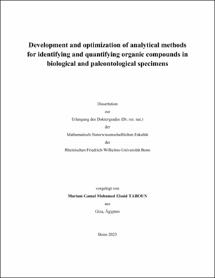Development and optimization of analytical methods for identifying and quantifying organic compounds in biological and paleontological specimens

Development and optimization of analytical methods for identifying and quantifying organic compounds in biological and paleontological specimens

| dc.contributor.advisor | Müller, Christa E. | |
| dc.contributor.author | Tahoun, Mariam Gamal Mohamed Elsaid | |
| dc.date.accessioned | 2023-12-01T13:08:33Z | |
| dc.date.available | 2023-12-01T13:08:33Z | |
| dc.date.issued | 01.12.2023 | |
| dc.identifier.uri | https://hdl.handle.net/20.500.11811/11158 | |
| dc.description.abstract | Preservation of soft tissues is a rare phenomenon which leads to the formation of fossils that survive for millions of years and are then subject to investigations by paleontologists. Several classes of chemical compounds have been reported to be preserved in fossils, including lipids, fatty acids, and porphyrins. However, the process of fossilization is not fully understood, which prompted investigations into the molecular aspects of decay, known as molecular taphonomy studies. The advancements of analytical techniques in recent decades have enabled progress in the field of molecular paleontology dedicated to the search for organic compounds in fossils and to understanding the changes that occur after death. Here, analytical methods are developed for the identification and quantification of organic compounds from biological, taphonomic, and fossil samples, applying various analytical techniques, including high performance liquid chromatography coupled to mass spectrometry and diode array ultraviolet/visible light detection, infrared spectroscopy, nuclear magnetic resonance spectroscopy, and atomic absorption spectrophotometry. First, since this dissertation deals largely with the chemical class of porphyrins, a review article is presented that provides a detailed overview on the chemistry of porphyrins in fossils (Chapter 3). This is followed by a review on the chemistry of the major classes of organic compounds detected in dinosaurs and the analytical techniques used for their identification (Chapter 4). A major part of the studies described in this dissertation aimed to establish and optimize an extraction protocol for heme, the prosthetic group of hemoglobin, from bone, with a high recovery rate, in order to be applied to analyses on fossil dinosaur bone (Chapter 6). Moreover, a molecular taphonomy study on heme was performed, elucidating the chemical degradation products of heme formed under conditions favorable to fossilization (Chapter 5). Furthermore, analytical methods were established for the quantification of two naturally occurring depsipeptides, FR900959 and YM-254890, from mouse organs after intratracheal and intraperitoneal administration, as well as the determination of their chemical stability in simulated gastrointestinal fluids (Chapter 7). Additionally, an analytical method was developed to detect fatty acid constituents of the plant polymer suberin, which is unique to bark, and the results were used to identify preserved bark in a 45-million-year-old fossil tree known as “monkey hair” collected in the Geiseltal Lagerstätte near Halle (Saale), East Germany (Chapter 8). Finally, several collaborative projects were completed, in which different analytical techniques were used to determine calcium concentrations, identify degradation products of fats in samples of the decaying crayfish Cambarellus diminitus, and to identify components of lignin in a fossil wood sample (Chapters 9-11). In summary, the findings of this dissertation demonstrate the power of analytical chemistry for analyzing a variety of compounds originating from diverse matrices, and contributes to the growing field of molecular paleontology. It provides novel findings and contributions to the fossil record, and presents analytical methods that may be applied in the future to study further specimens. | en |
| dc.language.iso | eng | |
| dc.rights | Namensnennung 4.0 International | |
| dc.rights.uri | http://creativecommons.org/licenses/by/4.0/ | |
| dc.subject.ddc | 500 Naturwissenschaften | |
| dc.title | Development and optimization of analytical methods for identifying and quantifying organic compounds in biological and paleontological specimens | |
| dc.type | Dissertation oder Habilitation | |
| dc.identifier.doi | https://doi.org/10.48565/bonndoc-170 | |
| dc.publisher.name | Universitäts- und Landesbibliothek Bonn | |
| dc.publisher.location | Bonn | |
| dc.rights.accessRights | openAccess | |
| dc.identifier.urn | https://nbn-resolving.org/urn:nbn:de:hbz:5-73031 | |
| dc.relation.doi | https://doi.org/10.3390/molecules28134887 | |
| dc.relation.doi | https://doi.org/10.3390/biology11050670 | |
| dc.relation.doi | https://doi.org/10.26879/992 | |
| dc.relation.doi | https://doi.org/10.1021/acsptsci.1c00021 | |
| dc.relation.doi | https://doi.org/10.1039/D0RA10688G | |
| ulbbn.pubtype | Erstveröffentlichung | |
| ulbbnediss.affiliation.name | Rheinische Friedrich-Wilhelms-Universität Bonn | |
| ulbbnediss.affiliation.location | Bonn | |
| ulbbnediss.thesis.level | Dissertation | |
| ulbbnediss.dissID | 7303 | |
| ulbbnediss.date.accepted | 30.10.2023 | |
| ulbbnediss.institute | Mathematisch-Naturwissenschaftliche Fakultät : Fachgruppe Pharmazie / Pharmazeutisches Institut | |
| ulbbnediss.fakultaet | Mathematisch-Naturwissenschaftliche Fakultät | |
| dc.contributor.coReferee | Engeser, Marianne | |
| ulbbnediss.contributor.orcid | https://orcid.org/0000-0001-8787-0399 |
Dateien zu dieser Ressource
Das Dokument erscheint in:
-
E-Dissertationen (4466)




